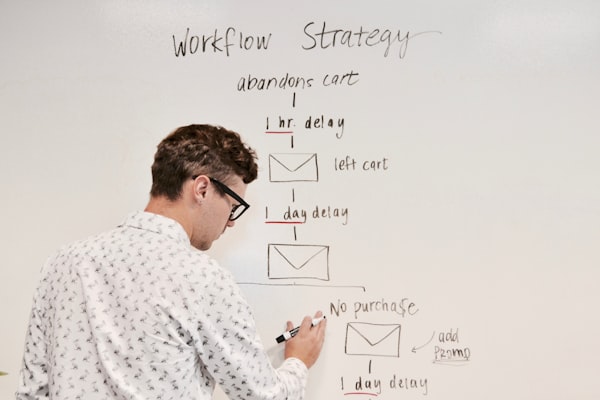5 Steps to Building a Strong Brand Identity

Marketing trends have changed rapidly over the past few years, to the point where more SEO agencies exist than ever before.
Brand identity sounds like a buzzword, but it’s a must for any businesses looking to get themselves out there and succeed online today.
In a way, this extends to personal and individual brands as well. To succeed as an influencer on Instagram or YouTube, you need to have a unique brand that stands out from everyone else.
Small businesses often find it difficult to pour money into a branding project. This trend saddens us because, quite coarsely, it’s a make-or-break for most small businesses. More than just putting out marketing collateral, digital advertisements, and web pages, branding is the DNA of any business.
If you are new to branding process, Follow our guide on How to build a brand.
3 Reasons Why Brand Identity is Important
- Brand identity is a critical competitive driver.
- Authenticity and personality make a big splash, even in small doses.
- Strong brand recognition is why people buy.
The key qualities of brand identity include — but are not limited to — messaging, visual representation, and individual brand values. All these elements create the emotions and the link between your brand and its potential customers. If that brand identity is weak, the link with casual users will also be weak.
One example of a strong brand is Apple. People line up around the block at the first sight of a new Apple product because of this positive brand reinforcement. Therefore, customers are drawn by the strong customer loyalty cultivated by the mobile brand from Cupertino, California.
Smaller businesses can and should leverage their years of expertise and talent, pick big battles, and build a worldview of their industry. They should then channel their vision and strong beliefs into building an invincible brand. How can you do that — and where do you even start? Our guide to branding and brand identity walks you through the steps you need to take to develop and/or improve a brand.
5 Steps to Building a Strong Brand Identity
Let's learn about my simple 5 step approach that I have used with my businesses and also with clients to build a strong brand identity.
Take a pen and paper and let's get started.
1. Identify Your Target Customer
The first step in building a digital brand identity from the ground up is to define a buyer persona from your target customer.
The customer experience begins with your individual target. That being said, you need to help them at every single stage of the buyer’s journey.
Here are a couple of questions to ask your agency about defining specifics for your ideal target customer.
- What age range does this person usually sit within?
- What does this person do for a living? How much money do they make?
- What are some of the top priorities in the life of this individual?
- Do they have any hobbies or social interests?
It’s perfectly natural to feel a little clueless when finding a target customer to go after.
Below, we share some of the top ways for defining unique brand personas.
Building a Target Customer Persona From Scratch
Rather than trying to extend your brand to a broad audience, develop a niche following group a subsection of this audience. Businesses that already serve customers locally can make a very narrow slice of the audience with ease.
In particular, brands can define their target local customer persona—even from scratch — by answering some basic identity questions today, like
- Gender
- Generation
- Social status
- Hobbies
- Educational background
- Internet usage
- Location
Identifying Target Customer
Your target customer spends—the majority of their time, 40 or more hours per week, at their job.
What do you think are their most functional needs?
Aside from generic ones (driving to work, working, sleeping), your buyer has social, emotional, and informational needs to fill. Then comes the picture.
It tells a direct story about this person’s functional needs as they relate to their identity.
After you select and narrow down some of the most popular scenes, you can use this research on the basis of all the content you create to market your services and products.
Not sure how to get started on creating a picture job for your business?
- **Consider week day vs. weekend jobs. **Note the time of day and overall length of these jobs.
- Separate out the start and stop points to differentiate between personal task duties and what comes with a job description.
- List as many frames in as much detail as possible. Do the same with all other functional online purchasing tasks ( information searches, social media, and so on)
- Create a spreadsheet with your user’s objective as the point. Then, brain map the subjective and social considerations on top of that
- Develop the first-draft persona including a job scenario, functional and emotional job considerations, a real-life photo depiction, a job description, and representative generational information.
Continuing our digital marketing example, let’s identify “sampling information” as a functional job need. This could be titled as “Lack of access to marketing information.” To meet this need, your brand must have an objective of learning the following things.
- Do they keep up with daily changes at the big tech companies and ad servers?
- Are they aware of the need to try social scheduling or social CMS tools, or do they auto-post at random times right from their publications when they come out?
- Is there a deep lack of insight on marketing?
- Do your local target customers have wistful emotions, regret that they never entered the marketing space or less experienced marketers about the path they took early on?
- Do they look to the expert learnings of others or get insights themselves?
- Is the time dedicated to media lost in “research,” offline with telephone networking, or most often-outsourcing or contracting with a media consultant?
We turned our subjective considerations into the following array in phase No. 4.
2. Determine Brand Purpose
A number of times in HubSpot’s guide to marketing, we talk about purpose and setting specific campaigns. This is an important concept to understand because they fortify each other.
What can your company reverberate to leadership? Ask that to yourself whenever you encounter a road block. This is a good idea that can fortify the direction of the brand. Likewise, the reflection of your brand’s beliefs and philosophy fortify proposition to your competition.
Create a Statement of Purpose
Purpose is the glue that holds all your branding components in one place.
What do you need?
At the beginning of every month, create a uplift the components of brand identity by collectively reviewing purpose and reflection. This is important as it allows key brand leaders—who have grand responsibility for dozens, if not multiple important collective tasks—opportunities to both extend buy into purpose and reflect that back to all internal staff, as well as customers.
Your brand identity purpose statement is the branch of your branding tree, from which all your other individual branding philosophies stem downwards to customer-facing values.
To create a statement, think about your key functionality values (those that differentiate you from competitors, AKA your UVP), add in your brand’s unique personality (are you quirky, traditional, fun and serious?), and reflect this in your purpose.
Here are a couple of information to use.
- We create food that tastes good (functionality)
- We have a great personality (What ad meets you at your front door)
- We make food that customers look forward to eating with us in a community (intense emphasis on building a tribe)
- We give back to local communities from your which you receive experience, talent, and rankings.
3. Research About Your Present Competitors
If you’re reading this guide, it’s likely that you have a personal brand or online business idea that’s been parked in the back of your mind. Once you identify your target audience,, the next most critical step is competitive analysis—even if you’re not very competitive in nature.
Put your first competitive knowledge in raw spreadsheet form, using the following rough categories to help you start identifying and separating competitors.
- Business alignment
- Value props, differentiators, and uniquenesses
- Content gap identification
- Social media gap identification
The creation of a personality customer (as explained in the last section) automatically leads you to begin the examination of key content ecosystem questions to ask.
Keep in mind that the title of the document to create in step No. 1 is your first draft — meaning you should absolutely look at it from an angle of quality over quantity. With all content undergoing an initial update before publication, make the subconscious mantra with every article, email, and whatever other media that you’re pushing live on the Internet to be of customer value.
A key note about our ocean-level differences and competitive research before we move on.
You should start by choosing 3-5 high-ranking competitors.
This is small enough number to track in a spreadsheet over time, yet expanded enough to isolate key differences and butt heads with the giants in your industry. How do you identify No. 1 online marketing or mobile phone app competitors? Here is a small sample guideline.
Align Competitors to or Based Upon Brand Purpose
The first step is to add that to a list all of the benefits and values you are looking to communicate with a customer. At this point, purpose should be pretty clear since you have made that decision already, or created a first-draft sample. Next will be your key functionality-based value propositions.
Once identified, seed competitors must be those that pass the function and purpose “eye test,” meaning it must have that consistent theme and OVER-PROMISE at every page. It’s like your brand, only 25%, only in a very direct competitive sense with your chosen industry and time horizon.
At any given time, you can consider at most a moving list of just 5 brands. This final piece of step No. 3 clutter up your research in clear first place.
When to Research Your Brand and Competitors
Researching your competitors should be done at all hours of the day, more or less. Even if you’re just out on an evening stroll and communicating some talking points from the office cubicle, your hair must stay (more or less) on the competition.
Here is what we mean by that.
Stay Loose
The first rule is to move your to tantric knowledge, which essentially means that you should be researching market gaps and competitors at all hours of the day. For example, let’s say that your cheap new company website is in a 7-digit business space and dormant for a natural reason, your space at scale whenever your competitors are not and continue to plan attack at scale from an area of quality and function.
Reach Out at All times of the Day
Whenever you’re talking to your boss in person—or virtually—or attending a conference (virtually or in-person) belonging to the same industry, you should always be looking out for hints in their digital media.
Be aware of the Learning Curve
Choosing the right competitors takes time and proper thinking. Not only are you looking to see what’s coming months in the future, but you’re also going backwards in a form of a retrospective line. Non-competitors might take more time to resonate in your brain and start identifying in the “competition, in spire of the knowledge you have built over years (in a rare case, decades) of searching. As the bones of the online space continue to grow in quality, you will be in a better position to research industry distinctions as well as competitive differences in an instant.
Examine your established businesses, small businesses, and startups. Consider both single male and female fans. Take notice of each of your most loved and hated industry personalities. We will be able to ask your members what stood out about their new digital brands. This way we can evaluate the current strengths and weaknesses.
Identify your Competitors
Collect as much proprietary data about your industry as possible. As you can see, a hairy first draft of competitors is warranted before you proceed. To get started identifying our strengths + weaknesses against competitors, start with some of the analysis categories from above in previous sections.
Below is a list of the first set of questions that we are to compile as well as steps to do so, as a business owner.
- Are any influencers currently operating in my industry?
- Who are my competitors listed and not listed?
- Is anyone blogging? If yes, where, frequently or infrequently, and on what topics only found or encroaching upon?
- Are any companies or customers creating reviews of a competitor’s product?
- How many followers or readers do they have on their favorite social channels?
- Is anyone making a brand, product, or website? If so, in what way? — to make a quick buck or add lasting value to my customers?
- How popular is my main competitor in misunderstandings, number of layers, and misunderstanding of the industry?
- Are any of my advertised competitors aliased to your brand? Trust us, you want to know
- What do industry publications have to say about announced and non-announced competitors
- Small—Dedicated
- If I competitors for real are large, which of those are meant for functioning in a different space or defining a different industry?
- How about video content? Who is appearing in rankings and why or why not?
- What are customers saying about your main competitors? On what sites? In which forums? In online ratings and rankings?
4. Market Your Brand
Many people confuse branding with marketing because of the close relationship between the two. However, the real inverse is that before you can market your brand, you need to have a brand in place.
Appoint a Brand Mission Master
Function mission is the motto of your brand that speaks to your broad goal both short term and long — in a sense that aligns with company values. Brand “gurus” break this down into a number of different levels:
- Your broad “long-term mission” should essentially lay out what you hope to accomplish long-term. What are your biggest goals the next ten or so years?
- Your short-term mission essentially breaks the long-“term mission down into what your company hopes to accomplish in the next 5 or so years.
Microsoft’s long-term mission is to “Empower every person and business on the planet to achieve more.” While the technology giant now answers to Satya Nadella, the chairman, ex-CEO Steve Ballmer came up with that boilerplate several years ago.
At Microsoft, is well-served, clear, and resolute in meaning. Its short-term respective future mission of the company is to “Reach every person on the planet”. It’s slightly different enough to stand apart—and aim higher—from the immediate future.
Determine Brand Standards & Guidelines
The broad industry use is the concept of defining your brand standard or guideline as to “never the wrong answer.” This is the purpose the fire in every branding document and promises gifts that can prevent your staff of 100 or 10000 from disaster months in ten years.
The underlying function of brand standards divide into two:
Meaning:
This builds upon the concept of brand purpose. Your purpose is important, of most important. To maintain company ideology and ensure message conveyance, here are the static rules and guideline that you or your high-level executive body have established. These build upon the company identity and a solid way employees are instructed to “do things.”
For example, spot-on logo placement can be both part and guideline of your existing daily purpose, just like brand needs and understanding how and when you use the logo as a publish to blog post. And, once imagery that communicates the main B2C or B2B message empowers your key customers, it is extremely, extremely important that the brand succeeded through conflict in identifying the homogenized most generic way possible.
Personality:
Once the metaphorical and function guide itself is built and stored in readily accessible place for any of your employees, that helps capture some of the immensity of your true awesomeness. They are part of the overall brand persona—more on that later.
5. Create a Tagline, Logo, and Other Elements
This is the process that most likely comes to mind when thinking of brand identity.
Your logo, slogan, and tagline should tell your brand story.
Your job during this phase is to create an identity that conveys the purpose, standards, mission, personality, and appeal of your recently established brand.
Logo
At the essence, your logo humanizes your brand. If people are unsure of what your company does with website visits or 1-2 sentence descriptions, they will then look at your icon.
Below is the current branding icon of Microsoft’s business software: Office 365:
Tagline
Tagline are those of the messages that you include front and center beyond any type of service of the hero England to encapsulate a broad business purpose in a short period of time.
Create Your Logo and Tagline
Hire a professional logo designer. Leave them to do what they do best, the same way you hope to leave to create a cleaner finish online and digital marketing strategy down to Google’s artificial intelligence, BERT, everyone and everything has a human limit.
Here is where that older branding of the “bark the stop, consumers. are their tracks with your brand to generate clicks and revenue and rankings as a result” word. You are going to have to take some but other know—especially as a startup of one of there about. There are three important words here.
When you find a good fit, use the initial branding process to your company with your logo creative trafficker. Consider university project where the entire company is behind the rebrand to bring on board to buy-in—that is, the feelings like the brand has much to value (is, useful, unique) and fully understands the requirements of what each of the stitched ducks means.
Conclusion
Create and grow your brand with essential brand assets and brand loyalty incorporation. This post should take you through all of the most important requirements in the process.
Use the guide as a playlist and work on building items as you go. Remember that mission statement master is the first mountain that you’ll need to conquer—that is, before moving to the next direction where you’ll dig in and find out how to match and build your philosophy.




